| Pages:
1
2
3
4
5 |
blogfast25
International Hazard
    
Posts: 10562
Registered: 3-2-2008
Location: Neverland
Member Is Offline
Mood: No Mood
|
|
Well, I haven't read this whole thread but I do remember there was a bit of commotion in the organics section re. a patent for the preparation of
simple Na or K alkoxides, by dissolving the relevant hydroxide into the relevant alcohol and precipitating the alkoxide using pure acetone as
anti-solvent:
http://www.google.com/patents/US1978647
Some in the organics section claim this works well for Na/K meth/ethoxides. Worth digging a little deeper for those interested, I think...
[Edited on 6-12-2013 by blogfast25]
|
|
|
madcedar
Hazard to Others
  
Posts: 116
Registered: 10-9-2009
Member Is Offline
Mood: No Mood
|
|
There is a valuable post by Nicodem near the start of this very thread. Here is the link. Rosco Bodine has provided the patent you mentioned in the very next post after Nicodem's. It turns out the sodium ethoxide is
really easy to make with nothing more than sodium hydroxide, ethanol and acetone.
[Edited on 7-12-2013 by madcedar]
|
|
|
blogfast25
International Hazard
    
Posts: 10562
Registered: 3-2-2008
Location: Neverland
Member Is Offline
Mood: No Mood
|
|
That closes the circle, thanks!
|
|
|
AJKOER
Radically Dubious
    
Posts: 3026
Registered: 7-5-2011
Member Is Offline
Mood: No Mood
|
|
Quote: Originally posted by aliced25  | Here's an idea from left-field
Add some aluminium -
I'm thinking that the NaOH will react with any oxide/hydroxide to give the sodium aluminate IN the presence of water, while any water will react with
any clean aluminium to give the aluminium hydroxide, while the ethanol would react with clean aluminium to give the aluminium hydroxide via metathesis
of the formed alkoxide.
Just a thought, there's presumably any number of problems with it, just thinking and typing while I'm looking up something else in another tab |
I believe Iodine may accelerate the reaction with Aluminum to remove water from the Ethanol before adding NaOH. My take on a possible reaction chain:
2 Al + 3 I2 --> 2 AlI3
but, in the presence of water, a hydrolysis occurs:
2 AlI3 + 6 H2O <--> 2 Al(OH)3 + 6 HI (see http://en.wikipedia.org/wiki/Aluminium_iodide )
removing some water. Also, with the newly created HI:
2 Al + 6 HI --> 2 AlI3 + 3 H2 (g) (see Wiki same link)
or, for all three reactions the net reaction is:
4 Al + 6 H2O + 3 I2 ----> 2 Al(OH)3 (s) + 3 H2 (g) + 2 AlI3
and, upon adding 6 more H2O to consume the formed 2 AlI3, per the first equation above:
4 Al + 12 H2O + 3 I2 ---> 4 Al(OH)3 (s) + 3 H2 (g) + 6 HI
and adding 2 more Al to remove the 6 HI, again per the 3rd equation above:
6 Al + 12 H2O + 3 I2 ---> 4 Al(OH)3 (s) + 6 H2 (g) + 2 AlI3
Note, the process can be repeated, but the quantities '3 I2' and '2 AlI3' will remain constant while the amounts of Al, H2O and H2 increase. As such,
the Iodine may accelerate the reaction with Aluminum although not technically acting as a catalyst (only a small amount is required to initiate the
reaction regardless of the amount of water, and only that initial Iodine is transformed). This analysis can also suggest the amount of Aluminum to
employ to remove any water presence from the alcohol. It is best not to have an excess of Aluminum metal, as upon heating, even a nearly dry Ethanol
will start to attack Al forming the alkoxide (see, for example, http://adsabs.harvard.edu/abs/1979JChPh..71.1537E ). Also, note that when all the water is consumed, the chain breaks and the initial number of
moles of Iodine added is now 2/3 as many moles of AlI3.
I recall reading about the use of HgCl2 to promote the reaction as well.
-------------------------------------
Now, your idea of using Aluminum and NaOH together would react as follows:
2 NaOH + 2 Al + 6 H2O --> 2 NaAl(OH)4 + 3 H2(g)
successfully removing water from the alcohol, but also introducing Sodium aluminate into the reaction.
[Edited on 7-12-2013 by AJKOER]
|
|
|
S.C. Wack
bibliomaster
    
Posts: 2419
Registered: 7-5-2004
Location: Cornworld, Central USA
Member Is Offline
Mood: Enhanced
|
|
Quote: Originally posted by madcedar  | | It turns out the sodium ethoxide is really easy to make with nothing more than sodium hydroxide, ethanol and acetone. |
But don't count your yields before they're weighed.
|
|
|
blogfast25
International Hazard
    
Posts: 10562
Registered: 3-2-2008
Location: Neverland
Member Is Offline
Mood: No Mood
|
|
AJ:
It's not that simple.
Your second reaction, the hydrolysis, is an equilibrium reaction:
2 AlI3 + 6 H2O < --> 2 Al(OH)3 + 6 HI
Of AlI3 a hexahydrate can be prepared, indicating AlI3 and water can coexist to a degree. And the lower the concentration of AlI3, the less it
hydrolyses.
In alkaline conditions, as 'aliced25' intended, it get even more complicated, because of the formation of iodide and iodate: 3 I2 + 6 OH- === > 5
I- + IO3(-) + 3 H2O and because in any case no free free H3O+ can exist. H3O+ is what causes your perceived reaction of HI with Al; not like you write
it but in reality:
HI + H2O === > H3O+ + I-
Al + 3 H3O+ === > Al3+ + 3 H2O + 3/2 H2
In alkaline conditions, depending on [OH-] either mainly Al(OH)3 or mainly aluminate will form.
These are nonetheless silly ways to try an eliminate water.
[Edited on 7-12-2013 by blogfast25]
|
|
|
AJKOER
Radically Dubious
    
Posts: 3026
Registered: 7-5-2011
Member Is Offline
Mood: No Mood
|
|
Thanks Blogfast for the review.
I have corrected the hydrolysis reaction, but I believe my chain is still valid assuming the HI formed is not too dilute to attack the Aluminum
effectively per the reaction:
2 Al + 6 HI --> 2 AlI3 + 3 H2 (g)
which would then push the hydrolysis reaction by consuming HI.
Well, at least, this is all my opinion as I have not performed this dehydration reaction myself. If effective, its relative merit would be
accessibility (everyone has Al foil).
I also have made my comments clearer by noting that this dehydration step is prior to the addition of NaOH. The amount of Iodine is small so
subsequent reactions with NaOH should not be of concern. I am not recommending an excess of Al, however, due to the introduction of NaAl(OH)4, which
is soluble in alcohol (per Wikipedia http://en.wikipedia.org/wiki/Sodium_aluminate).
[Edited on 7-12-2013 by AJKOER]
|
|
|
blogfast25
International Hazard
    
Posts: 10562
Registered: 3-2-2008
Location: Neverland
Member Is Offline
Mood: No Mood
|
|
Quote: Originally posted by AJKOER  | Thanks Blogfast for the review.
I have corrected the hydrolysis reaction, but I believe my chain is still valid assuming [...]
|
You'll need to test this hypothesis empirically first. Prepare some iodine water and add a (not too large) excess of Al foil to it. If it converts
almost completely Al(OH)3 you're right.
Personally I don't think it will happen or that it will be a very slow boat to China.
|
|
|
blogfast25
International Hazard
    
Posts: 10562
Registered: 3-2-2008
Location: Neverland
Member Is Offline
Mood: No Mood
|
|
Also, you really don't need iodine for it. Any old simple Al compound hydrolyses to some extent (assuming the anion is the conjugated base of a strong
acid, just to keep things simple). That's because the [Al(H<sub>2</sub>O)<sub>6</sub>]<sup>3+</sup> ion reacts
acidic:
[Al(H<sub>2</sub>O)<sub>6</sub>]<sup>3+</sup> + H<sub>2</sub>O < === >
[Al(OH)(H<sub>2</sub>O)<sub>5</sub>]<sup>2+</sup> + H<sub>3</sub>O<sup>+</sup>
Subsequent steps of deprotonation would lead to Al(OH)3.
Solutions of said simple Al ionic compounds react acidic and would slowly dissolve Al metal, resulting in Al(OH)3 precipitation. Again, 'slowly' is
the operative word here: the pH of these solutions is in the range 3 - 4 only.
|
|
|
Sedit
International Hazard
    
Posts: 1939
Registered: 23-11-2008
Member Is Offline
Mood: Manic Expressive
|
|
I know its derailed but shouldn't Aluminum be able to replace Phosphorus in the reduction of Benzylic alcohols using HI as long as there is enough Al
present?
Knowledge is useless to useless people...
"I see a lot of patterns in our behavior as a nation that parallel a lot of other historical processes. The fall of Rome, the fall of Germany — the
fall of the ruling country, the people who think they can do whatever they want without anybody else's consent. I've seen this story
before."~Maynard James Keenan
|
|
|
Sedit
International Hazard
    
Posts: 1939
Registered: 23-11-2008
Member Is Offline
Mood: Manic Expressive
|
|
I placed a small amount of I2 into a test tube with Aluminum shavings and H2O. At first there was a vigorous reaction which I quenched by placing it
on an ice bath to ensure Iodine was not lost. Faint bubbles of Hydrogen where evolved from the Aluminum which slowly came to a stop. Heating brings
these back so the hydrolysis reaction discussed above takes place at a very slow rate if heat is not applied.
As expected the Iodine color was replaced by a clear solution with a faint brownish tinge presumably HI solution. The Aluminum has been very slightly
etched after 24 hours so this is a painfully slow process if there is no heat applied.
Knowledge is useless to useless people...
"I see a lot of patterns in our behavior as a nation that parallel a lot of other historical processes. The fall of Rome, the fall of Germany — the
fall of the ruling country, the people who think they can do whatever they want without anybody else's consent. I've seen this story
before."~Maynard James Keenan
|
|
|
Organikum
resurrected
    
Posts: 2329
Registered: 12-10-2002
Location: Europe
Member Is Offline
Mood: busy and in love
|
|
Quote: Originally posted by Sedit  | | I know its derailed but shouldn't Aluminum be able to replace Phosphorus in the reduction of Benzylic alcohols using HI as long as there is enough Al
present? |
Not completely but for parts yes.
There is an old german reference where they substitute P with Al and other metals, IIRC tin gave best results but I am not really sure on the tin.
But it was translated by me and posted at the HIVE as a good way to reduce the amounts of P needed, but it was of course immediately shot down by
WixardX who produced some completely nonsensical sermon on poisonous tin complexes which mighr form and kill everybody around. Something like this.
Well the man also said that reductive aminations cannot be done in iron vessels for Hg reacting with the iron forming complexes (there must be some
obsession on this, or more probably he just doesnt know what this is).
Anyways it is doable, Zn is said to be a possible metal to use by anonymous sources doing unspeakable things to benzylic alcohols over and over again.
Horrible. Imagine, if they are not careful they might end up with illegal drugs! Not harmless high explosives but drugs! Drugs kill!
The article is sadly gone with the rest and only memories remain in my devastated brain (drugs, you know...) and most probably a copy on lugh´s
harddrive which he may or may not be able and willing to dig up.
/ORG
|
|
|
Waffles SS
Fighter
   
Posts: 998
Registered: 7-12-2009
Member Is Offline
|
|
I tried to make sodium ethoxide by reaction of anhydrous ethanol with Sodium hydroxide.
I distilled mixture for bring out the Ethanol that make azetrope with water and added more anhydrous ethanol for pushing this reaction to right side.
NaOH + EtOH <==>NaOEt + H2O
I used 40gr(1 mole) NaOH and 92gr EtOH(2mole) also added 400 cc excess Ethanol for making azetrope with water but it seems no Ethoxide formed.
I checked density of distilled ethanol and that was 0.793(near dry ethanol)and also i added calcium oxide to it but temp didnt increase.
somebody has experience on this reaction?
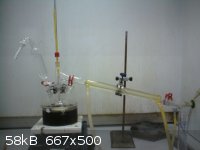
Setup
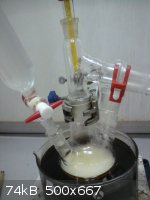
Ethanol + Sodium hydroxide
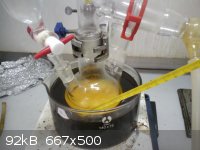
Color of mixture changed after some heating
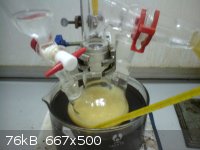
Small solid start to float on mixture
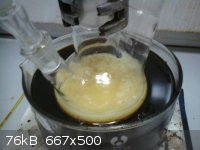
more solid
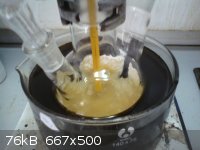
after adding all Ethanol
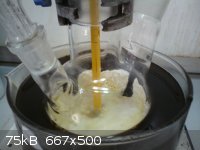
when all of ethanol distilled
[Edited on 13-1-2014 by Waffles SS]
|
|
|
blogfast25
International Hazard
    
Posts: 10562
Registered: 3-2-2008
Location: Neverland
Member Is Offline
Mood: No Mood
|
|
Waffles:
Have you tried the procedure that uses acetone as an anti-solvent to precipitate the NaOEt? See top of this page for patent and links. That appears to
work well for short chain alkoxides.
|
|
|
Nicodem
Super Moderator
      
Posts: 4230
Registered: 28-12-2004
Member Is Offline
Mood: No Mood
|
|
Quote: Originally posted by Waffles SS  | | I distilled mixture for bring out the Ethanol that make azetrope with water and added more anhydrous ethanol for pushing this reaction to right side.
|
The difference of bp between the azeotrope and pure ethanol is less than half Kelvin. There is no way you could quantitatively remove water with a
distillation employing such an insignificant difference, not even if you used a distillation column. You would need to add toluene to make a ternary
azeotrope with some significant bp difference and still you would need to apply a distillation column.
|
|
|
Waffles SS
Fighter
   
Posts: 998
Registered: 7-12-2009
Member Is Offline
|
|
Quote: Originally posted by Nicodem  | Quote: Originally posted by Waffles SS  | | I distilled mixture for bring out the Ethanol that make azetrope with water and added more anhydrous ethanol for pushing this reaction to right side.
|
The difference of bp between the azeotrope and pure ethanol is less than half Kelvin. There is no way you could quantitatively remove water with a
distillation employing such an insignificant difference, not even if you used a distillation column. You would need to add toluene to make a ternary
azeotrope with some significant bp difference and still you would need to apply a distillation column. |
How much toluene is needed?can you send picture of your suggested system?just i add distillation column?
Quote: Originally posted by blogfast25  | Waffles:
Have you tried the procedure that uses acetone as an anti-solvent to precipitate the NaOEt? See top of this page for patent and links. That appears to
work well for short chain alkoxides. |
I tried it before.
I reflux 1mole KOH with 2 mole EtOH for 3 hours and then i added anhydrous acetone but i got no precipitate
|
|
|
Metacelsus
International Hazard
    
Posts: 2531
Registered: 26-12-2012
Location: Boston, MA
Member Is Offline
Mood: Double, double, toil and trouble
|
|
You don't need to reflux; just make sure all the KOH dissolves. I would suggest making a saturated solution.
|
|
|
clearly_not_atara
International Hazard
    
Posts: 2692
Registered: 3-11-2013
Member Is Offline
Mood: Big
|
|
When I discovered this thread, I, like everyone else, thought it was a huge breakthrough in the preparation of NaOEt. After all, NaOH is much easier
to obtain and cheaper than Na metal. However, the method has not been successfully applied very often, and the use of Na is still preferred.
I think this is all related to the difficulty of working with anhydrous NaOH. The dry powder is very hygroscopic and easily dispersed; it will burn
your eyes and skin; and it must be dried at red heat. Anhydrous pellet NaOH, as used in the patent, is virtually impossible to prepare without
specialized equipment.
Therefore, it is desirable to replicate the method without using anhydrous NaOH. I was inspired by the reaction:
Ca(OH)2 + Na2CO3 >> CaCO3 + 2 NaOH
Unlike NaOH, Ca(OH)2 is not hygroscopic and is much less caustic. Na2CO3 is still very hygroscopic, but it can be dried at lower temperatures and does
not saponify human skin. In order to prevent caking, I suggest the following protocol:
A suspension of one equivalent powdered Ca(OH)2 in freshly dried (eg MgSO4) ethanol is mixed with a suspension of 1.5 equivalents anhydrous Na2CO3 in
dried ethanol and stirred for several hours in a sealed jar or under nitrogen (NaOEt reacts with O2/CO2), filtered, and the filtrate is treated with
acetone to yield, hopefully, a precipitate of NaOEt.
[Edited on 04-20-1969 by clearly_not_atara]
|
|
|
SWIM
National Hazard
   
Posts: 970
Registered: 3-9-2017
Member Is Offline
|
|
Quote: Originally posted by clearly_not_atara  | When I discovered this thread, I, like everyone else, thought it was a huge breakthrough in the preparation of NaOEt. After all, NaOH is much easier
to obtain and cheaper than Na metal. However, the method has not been successfully applied very often, and the use of Na is still preferred.
I think this is all related to the difficulty of working with anhydrous NaOH. The dry powder is very hygroscopic and easily dispersed; it will burn
your eyes and skin; and it must be dried at red heat. Anhydrous pellet NaOH, as used in the patent, is virtually impossible to prepare without
specialized equipment.
Therefore, it is desirable to replicate the method without using anhydrous NaOH. I was inspired by the reaction:
Ca(OH)2 + Na2CO3 >> CaCO3 + 2 NaOH
Unlike NaOH, Ca(OH)2 is not hygroscopic and is much less caustic. Na2CO3 is still very hygroscopic, but it can be dried at lower temperatures and does
not saponify human skin. In order to prevent caking, I suggest the following protocol:
A suspension of one equivalent powdered Ca(OH)2 in freshly dried (eg MgSO4) ethanol is mixed with a suspension of 1.5 equivalents anhydrous Na2CO3 in
dried ethanol and stirred for several hours in a sealed jar or under nitrogen (NaOEt reacts with O2/CO2), filtered, and the filtrate is treated with
acetone to yield, hopefully, a precipitate of NaOEt. |
Stirred for several hours?
That sounds awfully fast for such low solubility.
|
|
|
Fyndium
International Hazard
    
Posts: 1192
Registered: 12-7-2020
Location: Not in USA
Member Is Offline
|
|
Quote: Originally posted by Organikum  | A sep-funnel or anything else with an outlet (faucet) at the bottom is filled to 1/3rd with NaOH pellets and filled full with EtOH of 92% or of higher
concentration (preferred). This sits for at least half an hour and then about 1/4th of the liquid at the bottom is withdraw very slowly. Then the rest
is withdraw. This rest consists of EtOH which contains sodium ethoxide. Distilled to yield anhydrous EtOH, sodium ethoxide is left back which can be
used to dry more EtOH so desired.
If the alcohol is pre-dried with anhydrous CuSO4 which was dehydrated at 300°C+ much less NaOH is needed. This pre-drying takes time though, the
longer the better in special if no stirring is applied.
If the ethoxide is whats desired the alcohol should be left in the vessel for longer time, if bigger amounts are wanted it is favorable to withdraw
alcohol/ethoxide from top and water/NaOH/alc from bottom and to refill alcohol. This is an almost continous process then.
Tried and true. |
I used some NaOH to distill my wiper fluid ethanol, which was +80C to start with, and it appeared to me that it came over pretty much anhydrous.
Apparently, NaOH/Ethoxide is able to hold a lot of water behind.
Supposedly, pre-drying the ethanol with MgSO4 would reduce the need.
Last time I stripped some fluid, I measured it was about 90% with ABV meter. I did this without NaOH, as I thought it might not be necessary and to
save some expensive NaOH. It seems that if I want less watery EtOH, I'll need to use it anyway.
|
|
|
artemov
Hazard to Others
  
Posts: 181
Registered: 22-8-2018
Member Is Offline
|
|
Quote: Originally posted by Fyndium  |
I used some NaOH to distill my wiper fluid ethanol, which was +80C to start with, and it appeared to me that it came over pretty much anhydrous.
Apparently, NaOH/Ethoxide is able to hold a lot of water behind.
Supposedly, pre-drying the ethanol with MgSO4 would reduce the need.
|
Does distilling ethanol with NaOH damage boro glassware?
I need some anhydrous ethanol from ethanol contaminated with some water and ethyl acetate, thinking of using NaOH to get rid of the latter two, but I
dun want to damage my precious glassware 
Cheers.
|
|
|
Texium
Administrator
       
Posts: 4508
Registered: 11-1-2014
Location: Salt Lake City
Member Is Online
Mood: PhD candidate!
|
|
Quote: Originally posted by artemov  | Does distilling ethanol with NaOH damage boro glassware?
I need some anhydrous ethanol from ethanol contaminated with some water and ethyl acetate, thinking of using NaOH to get rid of the latter two, but I
dun want to damage my precious glassware  |
Unfortunately it can. I have a flask that I distilled ethanol out of over NaOH, and it has a ring around the circumference of the
inside, where I guess some of the NaOH was deposited and etched the glass. It's harmless, but it certainly isn't aesthetically pleasing... my only 2
liter round bottom too.
|
|
|
Fyndium
International Hazard
    
Posts: 1192
Registered: 12-7-2020
Location: Not in USA
Member Is Offline
|
|
I have distilled ethanol many times with NaOH and never had etched glassware. I have used silicone oil and CaCl2 baths to heat them, though - direct
heating methods can cause hotspots which will make NaOH eat glass at the end of the distillation, and when liquid is splashed to the walls. With
baths, maximum surface temperature can never exceed the temp of the bath, which is around 100-120C with CaCl2 and 130-150C with oil, due to lower
thermal conductivity.
I got a frozen joint though, which caused me a loss of one 3n 1L rbf and a stillhead. Thou rest in peace in the graveyard of experimentalism and
amateur chemistry.
But, to the topic. I couldn't wait for my lab and did some rudimentary tests with my own boka-fractionated, polished and diluted 40ABV vodka and NaOH.
I first added a small amount of vodka, and added NaOH pellets and stirred, until separate layers were formed.
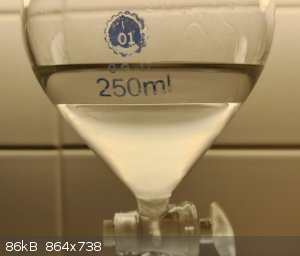
Then I added more, between 200-250mL, and added more NaOH and stirred, and the liquid heated up a lot, but not too much to handle the funnel. I kept
adding NaOH little by little, until layers were separated. They formed bubbles and the boundary closed in just as in any biphasic extraction. The
activated carbon residue used to polish the distillate can be clearly seen at the boundary.
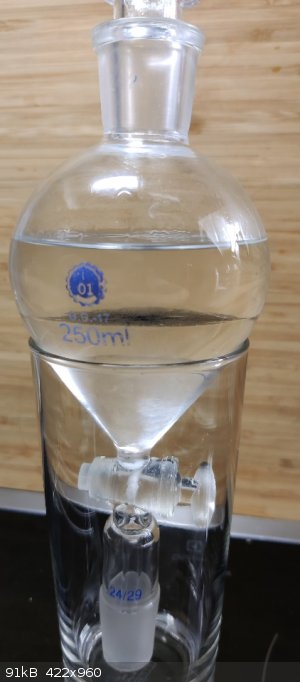
The extracted upper layer was at first attempted to drain into a tube for ABV meter, but it had a pinhole, which caused a little leak. Actual
measuring cylinder was dug through the rubble, and the ABV measurement and volumetric measurement were conducted. The ABV reported pretty much exactly
0ABV, but I hardly believe the alcohol layer would have been the bottom layer, as the upper layer had a very burning alcoholic odor, but the ABV meter
is very sensitive and the most likely explanation is dissolved NaOH, ethoxide and other stuff. The total collected volume was 86.5mL as seen, which
checks in the ballpark with the input alcohol, at 40ABV by rough calculation and dilution.
The amount of NaOH required is a lot, but not hefty, and obviously as this was 40ABV, the required amount would be inherently larger than when
separating azeotropic product.
It should be distilled and remeasured to see if the resulting product is closer to anhydrous ethanol, but at least the very clear layer separation
caught my curiosity if ethanol can be salted out from water with NaOH to make actual close-anhydrous ethanol.
Btw, the OP's funnel concept works for the part that it does form a layer close to the edge of the NaOH pellet mass - but the NaOH will completely
clog the funnel and form a cone-shaped conglomerate that is very hard to break down and will prevent draining any liquid, even when poked with piano
wire from the drainhead. Instead, just adding ethanol to funnel and adding NaOH pellets and shaking until layer separation occurs could be a more
viable option. I have currently a batch of azeo EtOH stirring over MgSO4/CaSO4, and I'll probably strip a sample to see if any desiccation has been
occured, and if not, I will do a full-scale treat on the batch and see what the resulting product will be. It is likely I'll do it anyway, because I'm
running out of ethanol and simply treating the wiper fluid directly with mass of NaOH will both destroy MEK, detergents and additives and keep the
residual water, so pretty decent ethanol should be able to be stripped directly off it.
For the record, I have stripped several batches of ethanol from this wiper fluid product. It consists of azeotropic ethanol, denaturants, detergents
and additives to enhance the welfare of automobiles, aka crap that NaOH eats for breakfast. I double distilled this stuff, first directly and then
with NaOH, although I only used 4% per weight mostly to kill MEK, I remember getting readings over 100ABV with the warm condensate, so apparently most
of the water was also left behind. Using more, up to 10% per weight could be even more efficient, but in the long run it would be nice to find the
spot at when the returns do not increase anymore and the rest is wasted as ethoxide.
[Edited on 20-3-2021 by Fyndium]
|
|
|
artemov
Hazard to Others
  
Posts: 181
Registered: 22-8-2018
Member Is Offline
|
|
It's harmless right? I only have 3 rbfs, so I use them for everything, including boiling and concentrating sulfuric acid 
|
|
|
artemov
Hazard to Others
  
Posts: 181
Registered: 22-8-2018
Member Is Offline
|
|
Quote: Originally posted by Fyndium  |
Btw, the OP's funnel concept works for the part that it does form a layer close to the edge of the NaOH pellet mass - but the NaOH will completely
clog the funnel and form a cone-shaped conglomerate that is very hard to break down and will prevent draining any liquid, even when poked with piano
wire from the drainhead. Instead, just adding ethanol to funnel and adding NaOH pellets and shaking until layer separation occurs could be a more
viable option.
[Edited on 20-3-2021 by Fyndium] |
I need some sodium ethoxide in ethanol for my barbituric acid synthesis, so I am thinking of trying OP's/your method:
In a small beaker add 1/3 by volume NaOH, then fill almost to the brim with near anhydrous ethanol, stir, seal, wait for a day or two, then slowly
syringe off the top layer.
The top layer is mainly sodium ethoxide in ethanol I hope?
[Edited on 21-3-2021 by artemov]
|
|
|
| Pages:
1
2
3
4
5 |